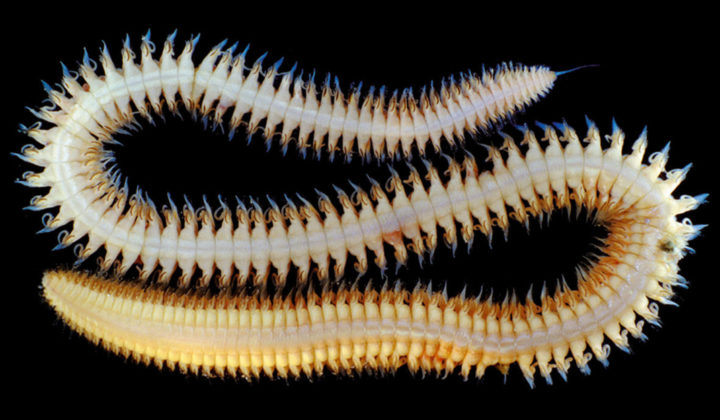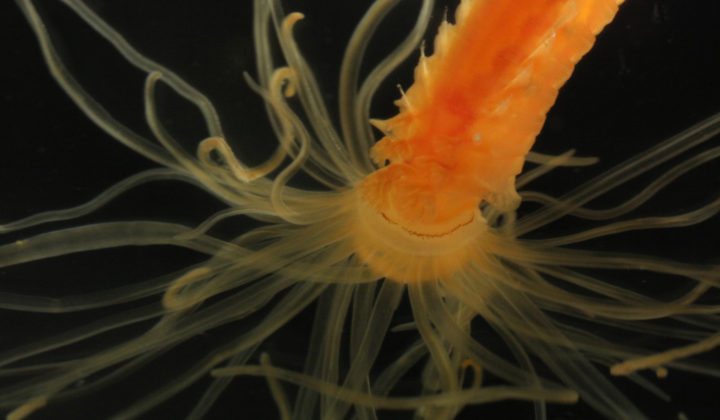In the following project phase the Polynoidae and Sigalionidae of the Arabian Seas were revised. All records listed in the checklist were checked together with additional, newly published specimens. The respective material originated from 19 international collections as well as own collecting in the Red Sea (Sanganeb Atoll, Sudan), Arabian Sea (Socotra Archipelago, Jemen), and the Persian/Arabian Gulf (Saudi Arabian coast) comprising more than 1.000 specimens. Specimens collected during important expeditions, e.g. the Austrian Pola-Expeditions to the Red Sea (1895-1896 u. 1897-1898) and collections of Senckenberg’s early naturalist Eduard Rüppell (1822-1827 u. 1830-1834) were studied and published for the first time. Detailed descriptions and figures were provided as well as identification keys to all taxa, and taxonomic problems were discussed. Discussions of the distribution, faunal affinities, Lessepsian migration and endemism were given in a zoogeographic account.
Polynoidae and Sigalionidae are represented in the region by 63 species from 35 genera.
For Polynoidae the occurrence of 44 species belonging to 23 genera and seven subfamilies was confirmed. Twenty-three species represent new records for one or more of the respective seas. Four new species were described: Harmothoe marerubrum n. sp., Lepidonotus polae n. sp., Parahalosydnopsis arabica n. sp., Pararctonoella marginopapillata n. sp. and Uncopolynoinae n. subf. is erected. Harmothoe grisea (Ehrenberg & Grube in Grube, 1869), Lepidasthenia nuda (Grube, 1870), and Lepidonotus impatiens (Savigny in Lamarck, 1818) were redescribed. The genus Bouchiria (Wesenberg-Lund, 1949), Iphione reticulata (Amoureux, Rullier & Fishelson, 1978), Lepidonotus impatiens meridionalis (Augener, 1913) and L. australiensis (Seidler, 1923) are considered junior synonyms. Harmothoe vesicudenta (Hanley & Burke, 1991) was transferred to the genus Malmgreniella (Hartman, 1967). The diagnoses of 10 genera were emended. The fauna documented is closely related to that of the Indo-West Pacific with at least 30 species out of 44 in common. Two species are likely to represent Lessepsian and two Anti-Lessepsian migrants. For the present, 10 species (23 %) are considered endemic to the area..
The Sigalionidae are represented in the region with 19 species belonging to 12 genera. Six species were new records for one or more of the seas. Additionally, one new genus and five new species were described: Mustaquimsthenelais dendropapillata n. gen. n. sp., Sigalion oligospinosus n. sp., Sigalion omanensis n. sp., Sigalion orientalis n. sp., and Sigalion socotrensis n. sp.. Sthenelais minor digitata (Fauvel, 1919) is considered a junior synonym of Fimbriosthenelais hirsuta (Potts, 1910). Diagnoses of two genera (Sthenelanella and Sthenolepis) are emended. Eight of the 19 species (42 %) are shared with other parts of the Indo-West Pacific. Only four species also ocurr in the Mediterranean Sea. Nine species (48 %) are presently considered endemic to the region. Fimbriosthenelais longipinnis is likely to represent a Lessepsian migrant.
Publications:
Wehe, T. & Fiege, D. (2002): Annotated checklist of the polychaete species of the seas surrounding the Arabian Peninsula: Red Sea, Gulf of Aden, Arabian Sea, Gulf of Oman, Arabian Gulf. Fauna of Arabia 19: 7-238. pdf
Wehe, T. (2002): Polychaete worms of the Socotra Archipelago – Preliminary Report on the survey period 29 March – 29 April 2000. Final Report of Phase III (Eds: M. Apel, K. I. Hariri and F. Krupp): Conservation and Sustainable Use of Biodiversity of Socotra Archipelago. Marine Habitat, Biodiversity and Fisheries Survey and Management. United Nations Office for Project Services (UNOPS YEM/96/G32) in conjunction with the Environmental Protection Council (EPC) of Yemen. pp. 391-393
Thomas Wehe (2004): Systematics and zoogeography of polychaetes occurring in the seas surrounding the Arabian Peninsula (Red Sea, Gulf of Aden, Arabian Sea, Gulf of Oman, The Gulf) with special emphasis on the revision of scale worms (Aphroditoidea: Polynoidae, Sigalionidae). PhD thesis, University of Heidelberg.
Mit finanzieller Unterstützung durch ein Landesgraduiertenstipendium der Universität Heidelberg, und der ProgrammeEU-IHP (Improving the Human Potential) COBICE (Zoologisches Museum Kopenhagen) und SYS-Resource (The Natural History Museum, London).
Wehe, T. (2006): Revision of scale worms (Polychaeta: Aphroditoidea) occurring in the seas surrounding the Arabian Peninsula. Part I. Polynoidae. Fauna of Arabia 22: 23-197.
Wehe, T., Fiege, D., & Storch, V. (2006): Borstenwürmer des Vorderen Orients. Geschichte und aktuelle Forschung. Natur und Museum 136 (9/10): 197-208. (ausführliche Version des Artikel siehe unten auf dieser Seite)
Wehe, T. (2007): Revision of the scale worms (Polychaeta: Aphroditoidea)occurring in the seas surrounding the Arabian peninsula. Part II. Sigalionidae. Fauna of Arabia 23: 41-124.
Wehe, T. (2017). New records of scale worms (Polychaeta: Annelida) from the Red Sea collected during the KAU–SRI biodiversity survey along the coast of Saudi Arabia. Families Iphionidae, Polynoidae and Sigalionidae. Marine Biodiversity 47(4): 1131-1136.



